|
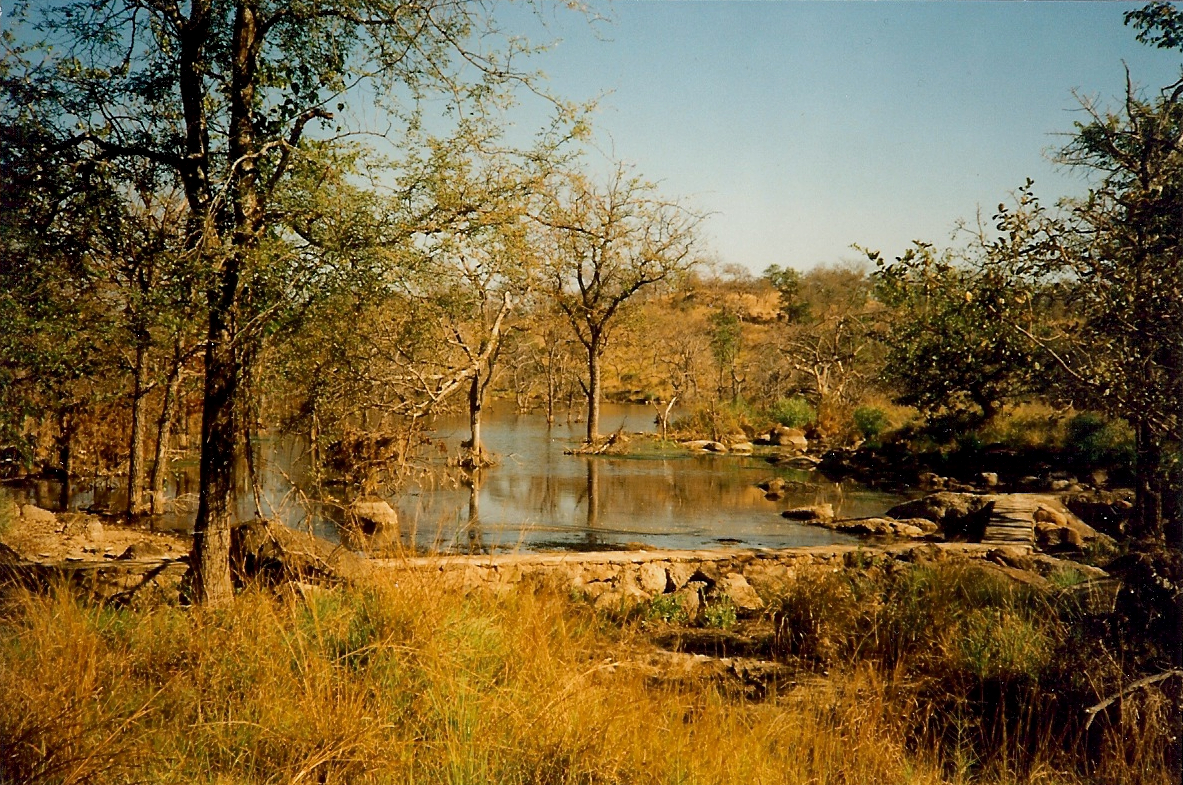
PARADISE FOUND
Text and photos by Cal Pappas
In John Milton's (1608-1674) Paradise Lost, man was forced
to exit the Garden of Eden due to his sin. And, for six thousand years, man has searched the globe for a suitable replacement.
While not as perfect as the Garden, Marakanga Ranch in Zimbabwe may just be as close as one can find today.
I
was introduced to Marakanga Ranch in a manner that is a bit unorthodox. I was there for ten days in June of 1997 as a hunting
client of a well known professional hunter, Barrie Duckworth, who had over-booked his own property and needed an area for
my plains game hunt. Barrie, one of the most respected men of his profession in Zimbabwe (and perhaps in all of Africa's hunting
community) chose the property of his close friend, Jerry Whitehead of Chiredzi, Zimbabwe.
The
story of the Whitehead's management of Marakanga begins in the late 1980s with the idea to expand the interests of the family
to working with land and game as Jerry had done in his younger days. Owning a successful engineering firm in Chiredze made
the thought of buying property a reality.
After
looking at several real estate parcels in southeastern Zimbabwe Jerry and his wife Rose settled on a section of the former
Nuanetsi Cattle Ranch. The Nuanetsi, a generation ago, was one of the world's largest cattle ranches. By the late 1980s its
million plus acres were broken up into several small ranches intermixed with native communal land. Any real estate agent worth
his salt would not have shown Marakanga to a prospective buyer. The land was over grazed, there was no surface water, and
only a half dozen impala remained on the scorched landscape.
The
Whiteheads drew from their knowledge of Africa to see a tremendous potential. One large valley with rock cliffs could hold
several year's supply of water if it was damned. On remote sections pans could be dug and water pumped from underground springs.
Water was the key. With water vegetation would grow. Then the animals would come. Another flight over the ranch in Jerry's
Cessna 210 closed the deal and Marakanga would now be theirs.
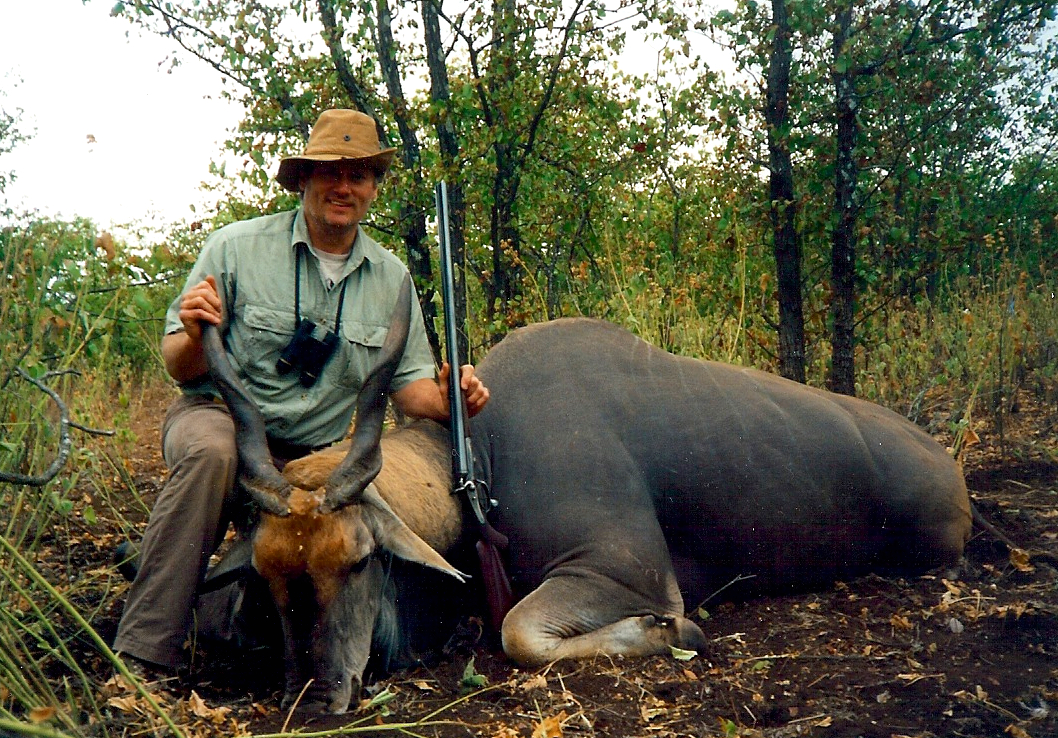
Jerry and Rose
purchased Marakanga in 1989. Working together with their son, Brian and daughter-in-law, Tammy, they have made Marakanga into
a prime hunting property that may well indeed be Zimbabwe's best kept secret.
The story of the growth of the ranch is a text book study of combining land management
and game management but is beyond the scope of this article. Skipping over the years, Nyala Dam was constructed to catch water
in the rainy season. Twenty-seven feet high it now dams water over one kilometer into an excellent fishing lake (with crocs,
too). A leak allows water to flow downstream in times of drought and six small pans have been dug to add water to outreaching
areas of the ranch.
Game was introduced to the ranch. Animals that managed to survive the trek across tribal
lands to Marakanga stayed. Today Marakanga is lush in vegetation and rich in huntable game. Herds of zebra, wildebeest, eland,
sable, greater kudu, impala, and waterbuck are seen daily as are dozens of giraffe plus warthog, wild pigs, nyala, bushbuck, duiker, baboons and monkeys. Breem and bass swim in Nyala Lake with the crocs and
150 species of birds grace the skies. A small section of the ranch is used to grow citrus with 6,000 grapefruit trees adding
to the income of the ranch (with 4000 more planned for the year 2000).
I hoped for a pleasant hunt for my introduction to Africa. Jerry flew to the Duckworth's
Mokore hunting camp to fetch Neil Duckworth (Barrie's son), my young professional hunter, and I. In less than an hour of flight
we approached Marakanga. The flight to Marakanga was quite a contrast to what
lay ahead. Over native lands I saw nothing but scorched earth. No animals. Not one! The land was brown dirt with a few dried
out trees. I thought to myself, "Some hunt this will be!"

|
| Jerry and Rose Whitehead at Marakanga Ranch |
Ahead was what
looked like an oasis. It was--an oasis named Marakanga. Green trees lined the far side of the dry riverbed of the formerly-named
Nuanetsi River. It was now the Mwenezi River. Beyond the river the land was rich in grass and trees and an abundance of game
was spotted from the air. My heart beat began to step up!
After landing, introductions, and putting away the gear Jerry drove Neil and I around
the ranch. "There are no game fences here," Jerry told us, "just border fences. The game just doesn't want to leave."
The first day of the hunt we concentrated on eland. Kudu was my first choice but eland
are the more difficult to hunt and not as common. First day success was not to be but the second was. We crossed eland spoor
in the early morning and began following the tracks of a small herd of bulls. After two hours we knew we were close. I should
clarify that statement. Neil and the tracker knew we were close--I didn't have a clue.
How these guys can track in the conditions on Marakanga is beyond me. Now I've hunted
off and on for nearly thirty years and can track a bit. It's even easy at times. But on Marakanga it is not an overstatement
to say that where ever one looks at the earth, the earth is covered by tracks. I mean everywhere! Yet the tracker could pick
out the tracks of my potential trophy and follow without error.
We were moving slow now. The eland were just ahead. Neil and the tracker could hear them
and so could I. The tracker stayed behind as Neil coached me to the slowest stalk I have ever experienced. Nearly two hours
were spent moving perhaps thirty yards. It was imperative the wind stayed in our favor. The last ten yards and one hour were
spent crab-walking with my Mortimer and Son .500x3-inch black powder express double rifle across my lap.
Neil was as still as a statue with his finger pointing to the front left. I inched closer
to observe a bull eland lying down and resting in the mid-day sun. He was old and steel-blue in color with horns worn down
from age. Neil thought he would measure 33-34 inches. Since eland was not my top priority I hoped to go better but, after
a stalk that stories are made from, I took the shot. Thirty to forty yards was a easy sitting shot with my elbows resting
on my knees. It was then I knew the advantages of an underlever hammer double rifle. I remembered John Taylor's writings of
how an exposed hammer rifle could be cocked without any sound. His theory worked! I held the front trigger back as my thumb
brought the right hammer to full cock. I did the same with the rear trigger and the left hammer. Complete silence.
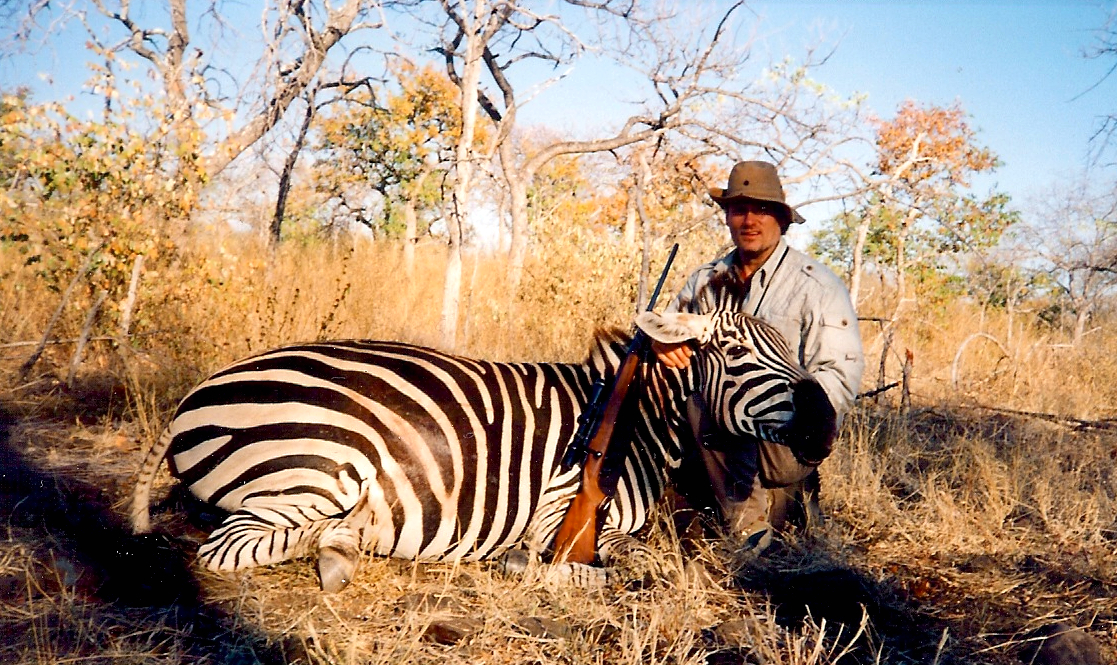
The shot rang
out and the eland started to rise. Neil shouted, "Hit him again" and the left barrel spoke. The eland went down with a shot
to the spine. My first shot was a poor hit--deflected by a blade of the tall grass I shot through from the sitting position.
Aiming at the shoulder, my bullet hit the neck and passed through with little damage. A good second shot saved precious time
searching for a wounded animal or perhaps a lost $1500 fee.
After the photos and handshakes the tape came out. Initially I was disappointed with
a 27 1/2-inch bull. But I had made the error so many of today's hunters make--that of putting measurement ahead of the quality
of the hunt. It was the best stalk of my life. Nothing will replace that. Now, when I look at my eland, I remember the experience
and not the horn length. Excluding the weight of elephant ivory, most of the old-timers rarely, if ever, mentioned measurements.
More was to follow. A zebra, impala, and baboon completed the hunt. A trophy kudu didn't
materialize although they were seen. But that was okay. I knew I wanted to return. Mentally I made plans for a 1998 hunt.
It was to be a two-part hunt. One for buffalo in the north with the Duckworths and another at Marakanga for plains game. Schedules
didn't match so the buffalo hunt had to be set aside.
June of 1998 was to be another hunt of future memories. This time kudu would be top priority.
During the pre-hunt drive around the ranch I saw my dream trophy. There in front of me was a bull that Jerry and Brian estimated
to be in the upper fifties and possibly stretching to the magic sixty- inch mark. Barry Duckworth, just passing through on
a visit, confirmed the huge bull. But I didn't have my rifle! I wasn't to hunt for two days and my just purchased 1926 vintage
Cogswell and Harrison takedown Mauser .375 lay in its case at the ranch. I had to be content watching this magnificent animal
trot off into the sunset. His massive horns were parallel to his back as he held his head high with pride.
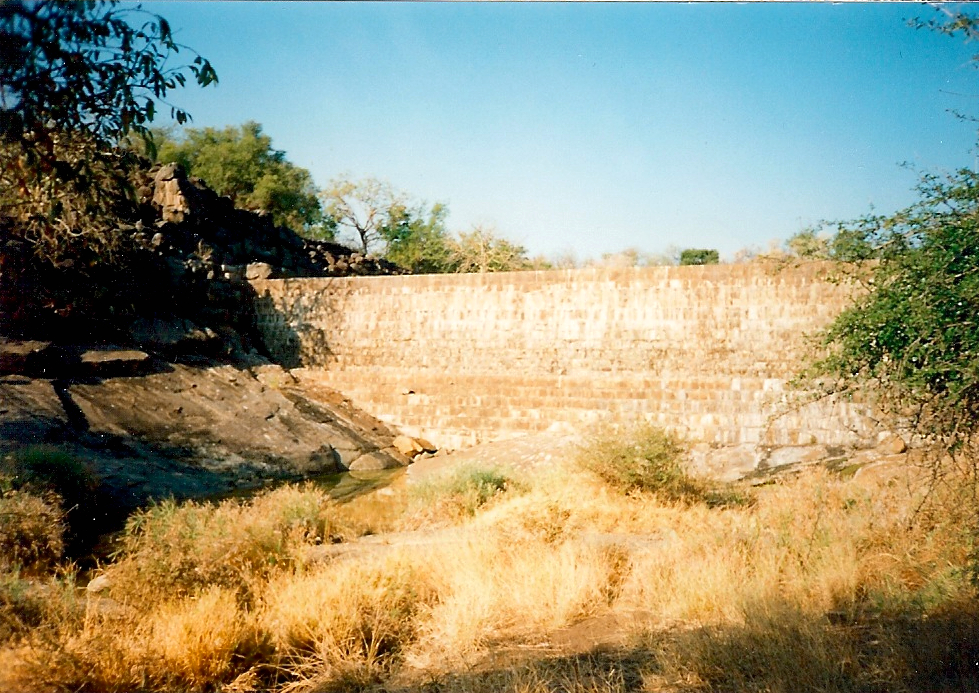
|
| Nyala Dam took three years to build--all by hand. The Whiteheads employ 40 Africans on the ranch |
Finding this
bull would be easy. It's track was huge. If Rowland Ward or SCI had a category of feet I would have my first world record!
The next day we returned to the area and picked up the spoor right away. We could hear
him barking in the trees but he was not to be seen. Not that day, or the next, or the next. And so it went for several days.
Tracks, a quick glimpse, barking, but no clear shot.
When we saw him the excitement grew. Just a shadow in the trees, that's all. His excellent
colors, horns that blend in with branches, combined with uncompromising sight,
smell and hearing work together to make the greater kudu one of Africa's most difficult animals to hunt.
It wasn't long before he spotted us and the chase was on! The thickness of the woods
worked to our advantage as well as to the kudu. We could not see each other very much. We began to parallel him--sometimes
moving very slow, sometimes at a full run--but the chance of an open shot seemed to elude me. Then, two hundred yards off
the bull stopped to look at us through the bush. Curiosity was to be his doom. I was panting like a dog in mid summer as I
tried to steady myself for a shot. The .375 roared and the kudu disappeared.
Running to the area, his tracks told the story in the earth. He moved away at high speed.
I was cussing my miss when the tracker spotted blood on the ground several yards away. After a short time to let the kudu
stiffen up we followed the spoor in to very thick bush. He was standing on a rise and I could only see his upper back and
lower neck. After three unsuccessful tries to find him in my scope at 1.5x, I removed the Griffin and Howe mount I took the
finishing shot, with open sights-through the neck, breaking the spine.
Moving to the bull, through the brush and into the small open space where he fell, I
noticed a beautiful horn. That's right, horn. Singular. We had managed to follow another bull with a huge track. A print longer
that a loaded .375 cartridge. Another bigfoot! The brush so thick we never got a good look at the quarry. We just assumed,
from the track size, we had the monster bull of the first day. The first shot took him in the lower chest, passed through
his body, and exited in front of the rear left leg.
The left horn was broken off at about fourteen inches. It was a great hunt and I wasn't
disappointed in the least. If I didn't get a trophy kudu this year I would the next. It was on this hunt I decided to hunt
Marakanga each year until I retire in 2004.

Two days later another kudu was spotted after two hours of tracking. Not the monster
we first saw, but a respectable bull of 53 1/2 inches. However, the highlight of my hunt was taking wildebeest of almost 31 1/2 inches after nearly a full day of tracking a small herd. It may be coincidence
that Marakanga has excellent wildebeest (several were spotted in the 30- to 31-inch range) as Jerry Whitehead holds the former
number three wildebeest in Rowland Ward. Three plentiful evenings of bird shooting brought my hunt to an end.
The summer of 1999 will see my third hunt on Marakanga. This time leopard (a dozen live
on the ranch), sable, and waterbuck are on my wish list.
The pleasant memories and thoughts of my hunts on Marakanga have many facets. First is
the quality of people the Whiteheads are. Committed to the land and game their ranch has evolved from a desert to a productive
game ranch. Ethical hunting is the rule and game is never shot from a vehicle. Fair chase tracking is the only method. Also,
due to the income from the citrus and the engineering company, hunting pressure is low. Four hunts per year is the norm with
one or two being bow hunts (Jerry and Brian are avid long bow hunters). With this is the guarantee that the client is the
only guest at the ranch during the hunt. No sharing the ranch with strangers. The Whiteheads will host only you and your party.
And of course the hospitality. Excellent food and accommodations, competitive daily rates
and trophy fees (excellent rates for leopard and sable), horseback riding (Tammy Whitehead owns a riding school), fishing,
bird shooting, plentiful game, and photography make for memories the client will have forever.
If you would like to know more about Marakanga Ranch feel free to contact the author
at 8100 Country Woods Drive in Anchorage, Alaska 99502 (907-522-8616) or write the Whiteheads directly care of Whitro Engineering,
PO Box 177, Chiredzi, Zimbabwe. I'll be there each June for at least five years. Perhaps I'll see you there--in paradise!
PHOTO CAPTIONS
1. Jerry and
Rose Whitehead at Marakanga Ranch.
2. Nyala Dam
took three years to build--all by hand. The Whiteheads employ 40 Africans on the ranch.
3. Nyala Lake
keeps the land and game watered even in dry spells.
4. Author's
second kudu.
5. Almost 31
1/2 inches put this wildebeest well in to the record book.
6. The result of an excellent stalk that illustrates the honor
in fair-chase hunting.
7. This stallion fell to the author's
.270 Weatherby (serial number 891).
8. Brian Whitehead who, in the author's opinion, is in dire
need of shotgun instruction and practice.
9. Another of Marakanga's dams which keep the ranch providing
water for the game even in dry spells.
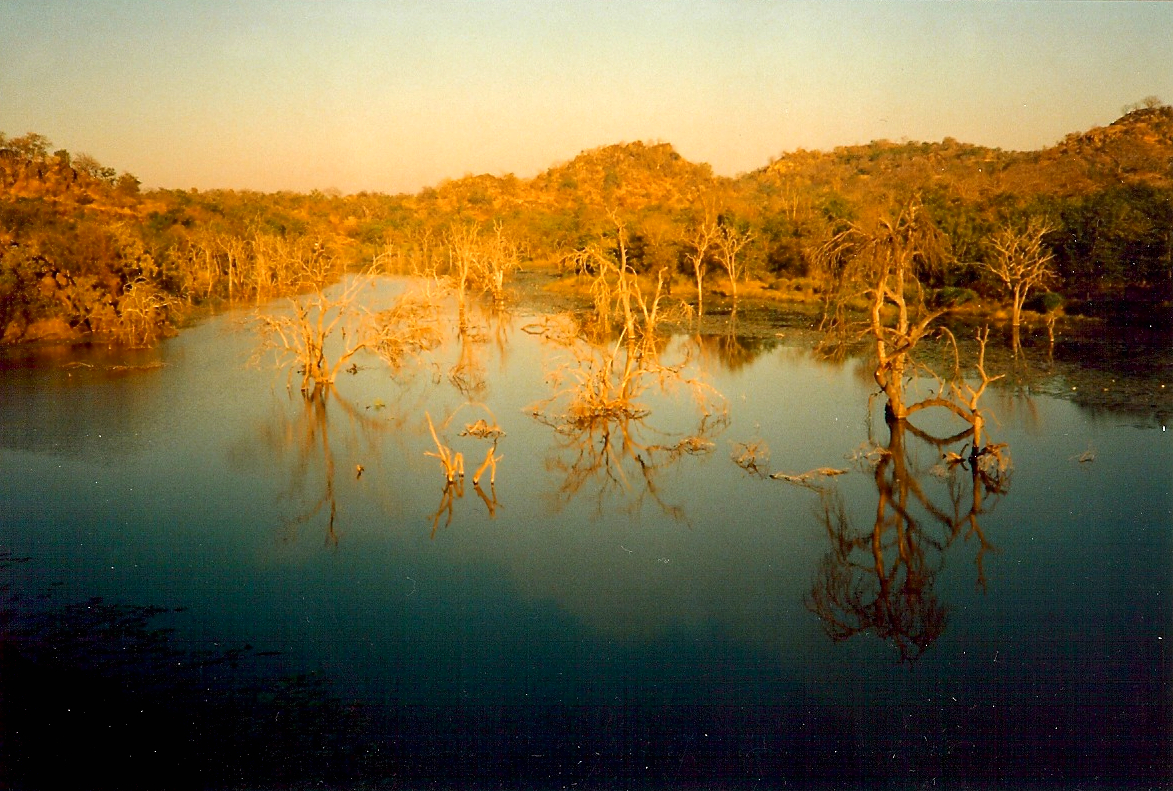
|
| Nyala Lake keeps the land and game watered even in dry spells. |
|

